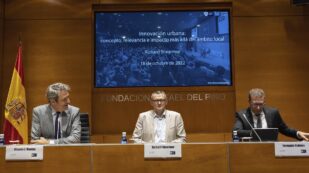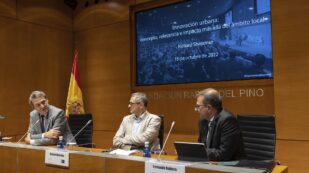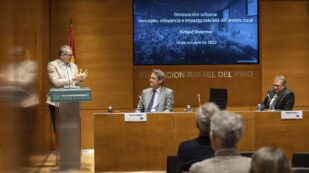Urban innovation: concept, relevance and impact beyond the local level
Summary:
On 18 October 2022, the Rafael del Pino Foundation and the Spanish Regional Science Association organised the keynote lecture "Urban innovation: concept, relevance and impact beyond the local level", given by Richard Shearmur, Professor and Director of the School of Urban Planning at McGill University.
To what extent does innovation in municipalities resemble innovation in the private sector, especially in SMEs? One of the characteristic features of SMEs is that they have a fixed location and are small in relation to the environment in which they operate. Most municipalities are also small. In Quebec there are more than a thousand municipalities and only thirty have more than 30,000 people. Most, however, are small and are located in one place, like SMEs. Neighbourhoods and districts within cities are also small and can influence the environment.
Municipalities are perceived as slow and inefficient. This negative reaction to municipalities is partly due to experience. People are aware of the blockages, the delays, the red tape. But this negative view is also driven by other ideas. There has been a lot of talk in recent years about the need for lighter business, that business thrives with less bureaucracy, with less red tape. In real estate, for example, many people are fed up with all the red tape before they can start building. But this is changing. A lot has been written in recent years, partly in academia, partly in consultancies. Governments have to be more intuitive and responsive to new technologies, so consultants are beginning to appreciate that governments have to participate in the change that is taking place. Mariana Mazzucato is the first person to stress the fact that governments can be very important, how to get an entrepreneurial state because innovation needs bureaucracy. The World Bank talks about how to improve public sector performance through coordination.
Things are now changing for a number of reasons. There have been a series of swings in the last few years. The dotcoms, the terrible recession of 2008. The government's reaction has been important to stabilise the economy during the Covid. The approach of low taxes, small government and minimal regulation has not been successful in these cases. No one is asking for a different environment, but there are limits to the reduction of taxes and regulation. The role of governments in relation to innovation is therefore currently being assessed.
Municipalities are not included in this vision, so do municipalities innovate or not? And if they do innovate, to what extent is this innovation different from that of the private sector? This question is important if we want to understand how municipalities function.
Trois-Rivières is a Quebec municipality of about 100,000 inhabitants that, in 2009, merged with a nearby municipality. The two municipalities had different IT systems, so they hired two IT experts who did their best to merge them. In 2011, these computer experts heard that there were problems with snowfall management because the snow was not being cleared, there were no trucks to load it. One of the engineers thought about solving it. The two went to talk to their bosses about their idea, which was to programme the snow ploughs to remove snow automatically. They went to the shop, bought GPSs and installed them in the machines. With this, they started to organise snow removal in a more systematic way. The result has been a cost reduction of 50% and less pollution. What would happen if all municipalities would consider this strategy?
We also see Boisbriand, of about ten thousand people, which is on the outskirts. The houses are close to the road. What can be done to reduce environmental noise? There are many examples in Europe of using trees and plants for this purpose. The problem in Quebec is the climate, which goes from -30º to 35º in summer. There is also a lot of salt. In winter it takes a lot of salt to melt the snow. So they couldn't find the right plants to protect themselves from the noise. They went to the nearest university and started experimenting with plants. They threw salt on them to see how they would grow, identified types of plants that would correct the problem, and planted them. This is very similar to entrepreneurial innovation. You have a problem, you do research, you see what the solutions are, you test them, and when you find a valid solution, you put it into action.
The Zambonis is a machine that makes beautiful ice for ice rinks. The water freezes perfectly, reflects and the rink looks great. Then the plates are put in place to protect the spectators. This used to be done manually. Now a crane is placed on the Zambonis, which moves across the ice and places the protection. It is a seemingly small innovation, but this is what SMEs do, innovating step by step. To be competitive they have to innovate in many different ways. If the person who introduced this innovation in Zambonis were an SME, they could sell it to the different municipalities.
Saint-Hyacinthe is a municipality of about fifty thousand people. They were the first in Canada to introduce a biomethane plant. It all started with a municipal engineer who said that something had to be done, because they were surrounded by agricultural activities that generated a lot of waste and something had to be done with it. The engineer said that in Europe they were using the waste to produce biomethane, so the municipality paid for him to go to Europe to see what they were doing there, he came back home and started working with other engineers to see what the optimal solution was. The project cost about fifty million dollars, so they sought funding at all levels, negotiated a contract with the private sector, gas suppliers to sell the surplus, and converted the buildings so they could be heated with that biomethane. It now collects waste from more than twenty municipalities.
These cases convince us that municipalities can innovate. When we talk about smart cities, these are innovations made by private companies. In the previous cases, they are innovations in which municipalities and their staff are involved. It is innovation that comes from within the municipality, it is not the municipality learning a technology that comes from outside.
In which areas do municipalities innovate? Well, it depends on what their competencies are. In the province of Quebec, roads are mainly the responsibility of the municipalities. There are many possibilities for municipalities to find new ways to pave them, to remove snow, and so on. Also in libraries, where they can look for new ways to attract children. Or in waste collection and treatment, drinking water, municipal police, fire brigade, urban planning, parks, traffic, ... Why not think that they are doing new things in the management of these competences?
Municipalities, however, are not private companies. To what extent is this innovation and to what extent is it not? We are talking about SMEs. Municipalities innovate in this way, not for profit. Who is the entrepreneur in the municipality? Where is the risk? The municipality has a captive market, but it also has a responsibility towards the citizens. There are the externalities and the challenge of intellectual property because there will be no patent. The innovator sells in the market. If not, it is an invention that goes nowhere.
In municipalities there is no profit motive, nor does innovation take place in a competitive environment, but they solve problems. They are not looking for new markets, but they encounter many problems, such as getting books into libraries, or getting snow off the roads, or managing waste. So one incentive for municipal innovation is problem solving. SMEs patent innovations, but municipalities do not.
Municipalities also innovate because they want to reduce costs, improve services and citizens' well-being, citizen consultation and participation processes, the environment. The motivation for public service is problem solving, around which everything revolves. Municipal innovators do not make money from their innovations, but they are all very proud that they have solved a problem and are enhancing the public good.
Who are these entrepreneurs? Often, they are employees and managers of departments and services, the people who go to put out the fires, bring the books to the children etc. They come up with an idea and have to get the resources to do something with that idea. They are rarely the politicians, but they play an important role because they can create and maintain an organisational culture that can accommodate such experiments.
Where is the risk? As in the private sector, the main risk is reputational. The organisation has a reputation to defend, just like entrepreneurs. Employees are using the municipality's time and resources, their bosses have often defended them in front of the hierarchy and if their idea does not work, they lose reputation.
At the municipal level it is very difficult to fail because of the accounting rules. When a municipality cannot explain where the money has gone, it is accused of being corrupt and inefficient. In a company it would be an innovative company. That is why we need stronger and more assertive politicians, who create the space for municipalities to innovate.
Municipalities are accountable to their citizens. Companies are accountable to their customers, who can choose whether or not to buy an innovative product. If it is a municipality, it has a responsibility to all residents, who have no choice. This difference has two consequences: the residents do not have a choice and the municipality has to be very careful about what it decides to innovate.
This leads to the next point about externalities and innovation. The municipality cannot say that its innovation is very good at removing snow, but it spoils the roads, because it is also responsible for the roads. So the negative impacts of an innovation cannot be charged to society. The municipality has to think about the surroundings, the environment, the social costs of the innovation, the social acceptability of the innovation. The municipality has to balance externalities and innovation much more than the private sector. That is why it innovates more slowly than a private company, because it has to take these elements into account and has to have the support of the citizens, otherwise it will lose their support in the next elections.
Then there is the question of intellectual property. In the era of smart cities, many innovations are public-private. This can cause problems. Cities do not own the intellectual property, have no control over data, are linked to technology monopolies and do not develop internal innovation capacity. Therefore, building innovation capacity in a municipality is very important. In the short term, it is easier to outsource innovations, but if you do it all the time, municipalities are not going to have in-house knowledge and expertise that leads to innovation. You need those experts to assess external technical solutions and adapt them. Often there is no simple solution. Each municipality has its particularities and often adaptations have to be made to these particularities.
Can municipal innovation be assessed and to what extent is it new? There is no simple way to measure it, we do not know if a municipality in another part of the world has introduced such innovation. But often the municipality can copy. What can be assessed is whether the innovation is new within a group of municipalities in a province. But even if it is not, is that a problem? In the end, the market of a municipality is its own citizens. Therefore, the criterion is whether the citizens believe that the municipality has been successful.
One very important thing with municipalities is that there is a lot of networking and a lot of exchange of ideas between them. They copy each other, they improve ideas, there is a continuous innovation that has much more impact than the previous examples. They can be an example for other municipalities, for other levels of government. They can be an example for citizens.
The Rafael del Pino Foundation is not responsible for the comments, opinions or statements made by the people who participate in its activities and which are expressed as a result of their inalienable right to freedom of expression and under their sole responsibility. The contents included in the summary of this conference are the result of the debates held at the meeting held for this purpose at the Foundation and are the responsibility of their authors.
The Rafael del Pino Foundation is not responsible for any comments, opinions or statements made by third parties. In this respect, the FRP is not obliged to monitor the views expressed by such third parties who participate in its activities and which are expressed as a result of their inalienable right to freedom of expression and under their own responsibility. The contents included in the summary of this conference are the result of the discussions that took place during the conference organised for this purpose at the Foundation and are the sole responsibility of its authors.










